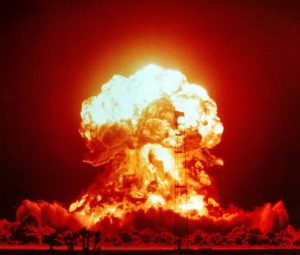 A 10 kiloton (10kt) nuclear detonation is one of the most complex scenarios emergency response personnel can face. During the week of May 2nd, EMSI helped Department of Energy (DOE) responders prepare for this very scenario during the Vibrant Response 2016 exercise.
A 10 kiloton (10kt) nuclear detonation is one of the most complex scenarios emergency response personnel can face. During the week of May 2nd, EMSI helped Department of Energy (DOE) responders prepare for this very scenario during the Vibrant Response 2016 exercise.
An annual exercise directed by U.S. Northern Command (USNORTHCOM) and executed by U.S. Army North (USARNORTH), Vibrant Response tests the capability of federal responders to manage a catastrophic incident. This year’s exercise scenario focused on a 10kt Improvised Nuclear Device (IND) detonation in Pennsylvania. As part of the exercise, the Federal Emergency Management Agency (FEMA) and their federal response partners, including DOE, established a Joint Field Office (JFO) in Harrisburg, PA.
A JFO is a temporary federal multiagency coordination center established to provide a central location to coordinate federal resources and support to a state following a Presidential Disaster Declaration under the Stafford Act. Although the JFO is managed using ICS organization and processes, it does not manage on-scene operations. Instead, the JFO coordinates directly with a state Emergency Operations Center (EOC) to ensure state and local response needs are met.
Vibrant Response 2016 marks the fourth consecutive year EMSI has supported DOE responders and worked with interagency partners in the Vibrant Response exercise series. A major exercise goal for DOE and FEMA this year was to implement and evaluate an evolving concept for coordinating and allocating federal radiological response resources at a JFO through the establishment of a Radiological Response Branch (Rad Branch) in the JFO Operations Section. Using lessons learned from previous hazardous materials response and complex incident management, EMSI has been integral in developing this new concept and has worked with DOE and FEMA to implement it during the Vibrant Response exercise series.
Involvement from the federal radiological response community in recent nuclear and radiological response exercises has highlighted the need to better integrate radiological incident management expertise into the JFO organization. Over the course of a nuclear or radiological incident, nearly every incident management functional element of the JFO organization will have their routine roles and responsibilities complicated by the impacts of the radiological hazard in the response. While this integration needs to occur across the entire organization, one critical area where this integration needs to be improved is in the Operations Section. Within Operations, the traditional JFO Branch level functional organizational structure of Emergency Services, Infrastructure, and Individual Assistance does not adequately accommodate the size and scale of the Federal radiological response. Additionally, the pool of specialized resources needed to execute the strategies and tactics related to the radiological hazard is extremely limited. The need to manage and prioritize these resources across the response is critical.
As a result, EMSI has worked with DOE and their federal radiological response partners, as well as FEMA, to establish the Rad Branch in the Operations Section. The primary function of the Rad Branch is to assess radiological response resource requirements and allocate resources to meet the incident priorities and objectives. During Vibrant Response 2016, the Rad Branch was widely regarded as one of the exercise success stories and was identified as a best practice. Additionally, the integration of DOE radiological response personnel into the FEMA IMAT organization, facilitated by EMSI, was identified as another best practice.
EMSI’s vast experience in complex incident management and hazardous materials response has helped inform some of the advanced incident management approaches to chemical, biological, radiological, and nuclear (CBRN) incident management. EMSI personnel have been involved in the management of several complex hazardous materials incidents, including Anthrax at the Capital (2001), the oil and hazardous materials response following Hurricanes Katrina and Rita (2005), Deepwater Horizon oil spill (2010), the Fukushima Daiichi Nuclear Disaster (2011), and the oil and hazardous materials response following Hurricane Sandy (2012).
EMSI has provided ICS and incident management training and support to DOE for over nine years and routinely provides support to DOE exercises. With a deep and seasoned cadre of Type 1 ICS practitioners and exercise planners, including Master Exercise Practitioners (MEPs), EMSI is uniquely positioned to provide development, coaching, and mentoring support to exercises. Click here to learn more about EMSI exercise planning and support services.

